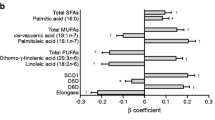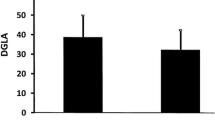Abstract
Previously we reported significantly higher values of γ-linolenic acid (GLA, 18∶3n−6), dihomo-γ-linolenic acid (DHGLA, 20∶3n−6), and arachidonic acid (20∶4n−6) in plasma lipid classes in obese children than in nonobese controls. In the present study, fatty acid composition of plasma phospholipids (PL) and sterol esters (STE) was determined by high-resolution capillary gas-liquid chromatography in obese children with an without metabolic cardiovascular syndrome [MCS: defined as simultaneous presence of (i) dyslipidemia, (ii) hyperinsulinemia, (iii) hypertension, and (iv) impaired glucose tolerance] and in nonobese controls. Fatty acid composition of PL and STE lipids did not differ between obese children without MCS and controls. Obese children with MCS exhibited significantly lower linoleic acid (LA, 18∶2n−6) values in PL (17.43 [2.36], %wt/wt, median [range from the first to the third quartile]) than obese children without MCS (19.14 [3.49]) and controls (20.28 [3.80]). In contrast, PL GLA values were significantly higher in obese children with (0.13 [0.08]) than in those without MCS (0.08 [0.04]), whereas STE GLA values were higher in obese children with MCS (1.04 [0.72]) than in controls (0.62 [0.48]). DHGLA values in PL were significantly higher in obese children with MCS (4.06 [0.74]) than in controls (2.69 [1.60]). The GLA/LA ratio was significantly higher, whereas the AA/DHGLA ratio was significantly lower in obese children with MCS than in obese children without MCS and in controls. In this study, LA metabolism was affected only in obese children with but not in those without MCS. In obese children with MCS, δ6-desaturase activity appeared to be stimulated, whereas δ5-desaturase activity appeared to be inhibited. Disturbances in LA metabolism may represent an additional health hazard within the multifaceted clinical picture of MCS.
Similar content being viewed by others
Abbreviations
- AA:
-
arachidonic acid
- DHGLA:
-
dihomo-γ-linolenic acid
- EFA:
-
essential fatty acid
- GLA:
-
γ-linolenic acid
- LA:
-
lmoleic acid
- LCPUFA:
-
long-chain polyunsaturated fatty acid
- MCS:
-
metabolic cardiovascular syndrome
- PL:
-
phospholipid
- PUFA:
-
polyunsaturated fatty acid
- STE:
-
sterol ester
References
Troiano, R.P., Flegal, K.M., Knczmarski, R.J., Campbell, S.M., and Johnson, C.L. (1995) Overweight Prevalence and Trend for Children and Adolescents. The National Health and Nutrition Examination Surveys, 1963 to 1991, Arch. Pediatr. Adolesc. Med. 149, 1085–1091.
Dóber, I. (1996) The Prevalence of Obesity and Super Obesity Among School Children of Pécs in the 1990s. Anthrop. Közl. 38, 149–155.
Must, A., Jacques, P.F., Dallal, G.E., Bajema, C.J., and Dietz, W.H. (1992) Long-term Morbidity and Mortality of Overweight Adolescents, N. Engl. J. Med. 327, 1350–1355.
Decsi, T., Molnár, D., and Koletzko, B. (1996) Long-chain Polyunsaturated Fatty Acids in Plasma Lipids of Obese Children, Lipids 31, 305–311.
Phinney, S.D., Davis, P.G., Johnson, S.B., and Holman, R.T. (1991) Obesity and Weight Loss Alter Serum Polyunsaturated Lipids in Humans, Am. J. Clin. Nutr. 53, 831–838.
Rössner, S., Walldius, G., and Björvell, H. (1989) Fatty Acid Composition in Serum Lipids and Adipose Tissue in Severe Obesity Before and After Six Weeks of Weight Loss, Int. J. Obes. 13, 603–612.
Baillie, G.M., Sherer, J.T., and Weart, C.W. (1998) Insulin and Coronary Artery Disease: Is Syndrome X the Unifying Hypothcsis? Ann. Pharmacother. 32, 233–247.
Liese, A.D., Mayer-Davies, E.J., and Haffner, S.M. (1998) Development of the Multiple Metabolic Syndrome: An Epidemiological Perspective, Epidemiol. Rev. 20, 157–172.
Arslanian, S., and Suprasongsin, C. (1996) insulin Sensitivity, Lipids and Body Composition in Childhood: Is Syndrome X Present? J. Clin. Endocrinol. Metab. 81, 1058–1062.
Chen, W., Srinivasan, S.R., Elkasabany, A., and Berenson, G.S. (1999) Cardiovascular Risk Factors Clustering Features of Insulin Resistance Syndrome (Syndrome X) in a Biracial (Black-White) Population of Children. Adolescents, and Young Adults: The Bogalusa Heart Study, Am. J. Epidemiol. 150, 667–674.
Csábi, G., Török, K., Jeges, S., and Molnár, D. (2000) Presence of Metabolic Cardiovascular Syndrome in Obese Children, Eur. J. Pediatr. 159, 91–94.
Parizková, J., and Roth, Z. (1972) Assessment of Depot Fat in Children from Skinfold Measurements by Holtain Caliper. Hum. Biol. 44, 614–616.
Moore, D.J., Durie, P.R., Forstner, G.G., and Pencharz, P.B. (1985) The Assessment of Nutritional Status in Children, Nutr. Res. 5, 797–799.
Tanner, J.M. (1962) Growth at Adolescence, 2nd edn., Blackwell Scientific Publications, Oxford, p. 325.
Task Force on Blood Pressure Control in Children, National Heart, Lung, and Blood Institute, Bethesda, Maryland (1987) Report of the Second Task Force on Blood Pressure Control in Children—1987, Pediatrics 79, 1–25.
Soergel, M., Kirschstein, M., and Busch, C. (1997) Oscillometric Twenty-four-hour Ambulatory Blood Pressure Values in Healthy Children and Adolescents: A Multicenter Trial Including 1141 Subjects, J. Pediatr. 130, 178–184.
Braham, D., and Tinder, P. (1972) An Improved Reagent for the Determination of Blood Glucose by the Oxidase System, Analyst 97, 142–146.
Guthrie, R.A., Guthrie, D.W., and Murthy, D.Y.N. (1973) Standardization of Oral Glucose Tolerance Test and Criteria for the Diagnosis of Chemical Diabetes in Children, Metabolism 22, 275–282.
Alberti, K.G.M.M. (1995) Impaired Glucose Tolerance—Fact or Fiction, Diab. Med. 13, S6-S8.
Steele, B.W., Rochler, D.F., Azar, N.M., Blaszkowszki, T.B., Ruba, K., and Dempsey, M.E. (1976) Enzymatic Determination of Cholesterol in High Density Lipoprotein Fractions Prepared by a Precipitation Technique, Clin. Chem. 22, 98–102.
Romics, L., Szollár, L., and Zajkás, G. (1993) Management of Arteriosclerosis-related Lipid Metabolism Disorders. Recommendations of the Hungarian Lipid Consensus Conference [in Hungarian with English summary], Orv. Hetil. 134, 227–238.
Folch, J., Lees, M., and Sloane Stanley, G.H. (1957) A Simple Method for the Isolation and Purification of Total Lipids from Animal Tissues, J. Biol. Chem. 226, 497–509.
Stoffel, W., Chu, F., and Ahrens, E.H. (1959) Analysis of Long-Chain Fatty Acids by Gas-Liquid Chromatography, Anal. Chem. 31, 307–308.
Decsi, T., and Koletzko, B. (1994) Fatty Acid Composition of Plasma Lipid Classes in Healthy Subjects from Birth to Young Adulthood, Eur. J. Pediatr. 153, 520–525.
Cunnane, S.C., Manku, M.S., and Horrobin, D.F. (1985) Essential Fatty Acids in the Liver and Adipose Tissue of Genetically Obese Mice: Effect of Supplemental Linoleic and Gammalinolenic Acids, Br. J. Nutr. 53, 441–448.
Blond, J.-P., Henchiri, C., and Bézard, J. (1989) δ6 and δ5 Desaturase Activities in Liver from Obese Zucker Rats at Different Ages, Lipids 24, 389–395.
Guesnet, P., Bourre, J.-M., Guerre-Millo, M., Pascal, G., and Durand, G. (1990) Tissue Phospholipid Fatty Acid Composition in Genetically Lean (Fa/-) or Obese (fa/fa) Zucker Female Rats on the Same Diets, Lipids 25, 517–522.
Phinney, S.D., Fisler, J.S., Tang, A.B., and Warden, C.H. (1994) Liver Fatty Acid Composition Correlates with Body Fat and Sex in a Multigenic Mouse Model of Obesity. Am. J. Clin. Nutr. 60, 61–67.
Clandinin, M.T., Cheema, S., Pehowich, D., and Field, C.J. (1996) Effect of Polyunsaturated Fatty Acids in Obese Mice, Lipids 31, S13-S22.
Phinney, S.D. (1996) Arachidonic Acid Maldistribution in Obesity, Lipids 31, S271-S274.
Brenner, R.R. (1981) Nutritional and Hormonal Factors Influencing Desaturation of Essential Fatty Acids, Progr. Lipid Res. 20, 41–47.
Brenner, R.R. (1991) Endocrine Control of Fatty Acid Desaturation, Biochem. Soc. Trans. 18, 773–775.
Brenner, R.R. (1977) Regulatory Function of Delta-6-desaturase—Key Enzyme of Polyunsaturated Fatty Acids Synthesis, Adv. Exp. Med. Biol. 83, 85–101.
Holman, R.T., Johnson, S.B., Gerrard, J.M., Mauer, S.M., Kupcho-Sandberg, S., and Brown, D.M. (1983) Arachidonic Acid Deficiency in Streptozocin-Induced Diabetes, Proc. Natl. Acad. Sci. USA 80, 2375–2379.
Huang, Y.S., Horrobin, D.F., Manku, M.S., Mitchell, J., and Ryan, M.A. (1984) Tissue Phospholipid Fatty Acid Compsition in the Diabetic Rat, Lipids 19, 367–370.
Borkman, M., Storlien, L.H., Pan, D.A., Jenkins, A.B., Chisholm, D.J., and Campbell, L.V. (1993) The Relation Between Insulin Sensitivity and the Fatty Acid Composition of Skeletal-Muscle Phospholipids, N. Engl. J. Med. 328, 238–244.
Cunnane, S.C., Huang, Y.-S., and Manku, M.S. (1985) Triacylglycerol Content of Arachidonic Acid Varies Inversely with Total Triacylglycerol in Liver and Plasma, Biochim. Biophys. Acta 876, 183–186.
Decsi, T., Molnár, D., and Koletzko, B. (1998) The Effect of Under- and Overnutrition on Essential Fatty Acid Metabolism in Childhood, Eur. J. Clin. Nutr. 52, 541–548.
Frelut, M.L., Therond, P., Camuso, M.C., Benali, K., Cathelineau, L., and Navarro, J. (1994) Inhibited Plasma Delta 6 Desaturase Activity and Abnormal Membrane Essential Fatty Acid Pattern in Obese Children. Impact of Weight Loss (abstract), Acta Paediatr. Hung. 34, 219.
Demmelmair, H., Sauerwald, T., Koletzko, B., and Richter, T. (1997) New Insights into Lipid and Fatty Acid Metabolism via Stable Isotopes, Eur. J. Pediatr. 156 Suppl. 1, S70-S74.
Cho, H.P., Nakamura, M.T., and Clarke, S.D. (1999) Cloning, Expression, and Nutritional Regulation of the Mammalian Delta-6 Desaturase, J. Biol. Chem. 274, 471–477.
Author information
Authors and Affiliations
Corresponding author
About this article
Cite this article
Decsi, T., Csabi, G., Török, K. et al. Polyunsaturated fatty acids in plasma lipids of obese children with and without metabolic cardiovascular syndrome. Lipids 35, 1179–1184 (2000). https://doi.org/10.1007/s11745-000-0634-7
Received:
Revised:
Accepted:
Issue Date:
DOI: https://doi.org/10.1007/s11745-000-0634-7




